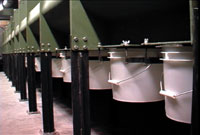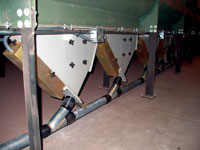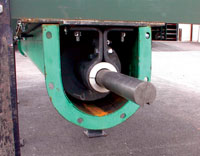The goal of every range should be to increase facility revenue. In order to achieve this goal, all range products and features should be carefully evaluated to ensure they maximize revenue and are aligned with the volume of range use. While the bucket system is the ideal solution for some ranges, Action Target recommends that all facilities with a Total Containment Trap engaged at a rate of 70% or greater should use the conveyor system. In these ranges, the conveyor system is the best solution to increase range revenue.
 Time is money. The more time the range is shut down for service, the less money the range is making. In other words, each time a range has to shut down should be viewed as a potential loss of revenue. A range using a conveyor belt doesn’t have to shut down in order to service the trap because the conveyor is constantly collecting the fired rounds. When the range does shuts down for general maintenance, the workers don’t have to deal with clearing buckets and can better spend their time elsewhere.
Time is money. The more time the range is shut down for service, the less money the range is making. In other words, each time a range has to shut down should be viewed as a potential loss of revenue. A range using a conveyor belt doesn’t have to shut down in order to service the trap because the conveyor is constantly collecting the fired rounds. When the range does shuts down for general maintenance, the workers don’t have to deal with clearing buckets and can better spend their time elsewhere.
It’s important to remember that labor is not free. Using buckets or canisters is seldom a viable solution because of the high amount of manual labor that is required, which greatly increases the cost of a bucket system beyond initial construction. Each of the canisters underneath the trap, when full, can weigh over 100 pounds. Due to the heaviness and awkwardness of these canisters, lead is often spilled and the canisters often become damaged. Workers then have to spend more time cleaning up the spilled contents. On a standard 10-lane range, there are more than 30 canisters to remove. If each of these canisters weighs about 100 pounds, there will be more than 1.5 tons of lead. By design, the canisters are meant to have a lid hammered on before removal. However too often, range operators choose to dump each of these buckets into a larger barrel or bin for removal. This creates an undue risk and safety issue as well as the potential threat of lead spillage, which again, requires additional cleanup and special handling. In short, while a bucket or canister system is less expensive initially, the cost of labor and upkeep quickly piles up.
 Contrarily, a screw conveyor removes the spent rounds and lead to a single location to be removed. The movement of the lead and spent bullets in the screw conveyor is hands-free; the only engagement is removing and replacing the large barrel after it is full. This can be done easily with a small forklift or a pallet jack and requires far less time and effort than that required with a bucket system.
Contrarily, a screw conveyor removes the spent rounds and lead to a single location to be removed. The movement of the lead and spent bullets in the screw conveyor is hands-free; the only engagement is removing and replacing the large barrel after it is full. This can be done easily with a small forklift or a pallet jack and requires far less time and effort than that required with a bucket system.
 A final reason why the conveyor system is recommended in Total Containment Traps is safety. If a canister is allowed to overfill, the rounds will remain in the bullet trap and can potentially cause ricochet and/or clogging. Barrels can become filled with lead in as little as two weeks. The more the lead piles up, the bigger the safety issue. Range safety is critical and the screw conveyor system is the best choice for optimal safety.
A final reason why the conveyor system is recommended in Total Containment Traps is safety. If a canister is allowed to overfill, the rounds will remain in the bullet trap and can potentially cause ricochet and/or clogging. Barrels can become filled with lead in as little as two weeks. The more the lead piles up, the bigger the safety issue. Range safety is critical and the screw conveyor system is the best choice for optimal safety.
To learn more about Actions Target’s Total Containment Trap, its bucket system, or its conveyor belt system, visit the Bullet Traps page.






